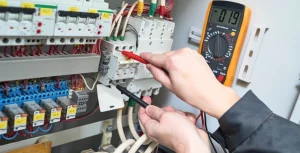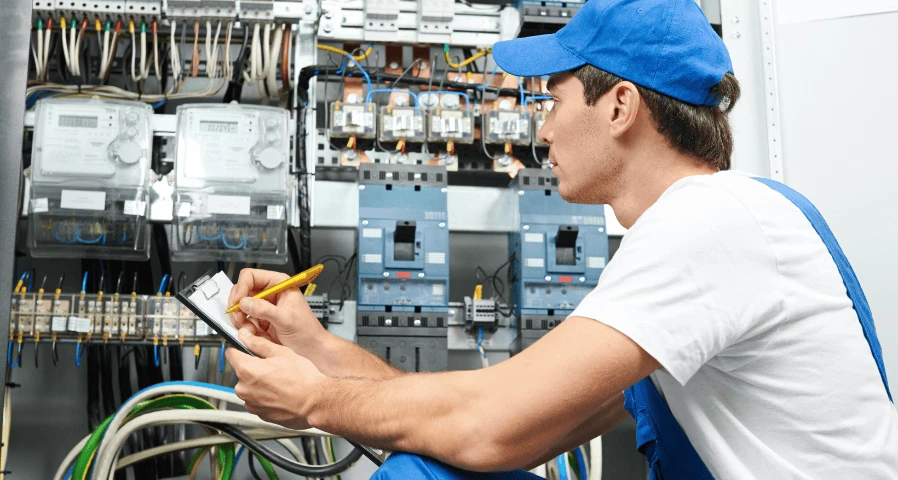Electrical safety in home gyms is often overlooked, yet it plays a critical role in overall fitness environments. Regular inspections can uncover hazards that may compromise safety during workouts. Identifying issues such as overloaded circuits and damaged cords is essential. Preparing for these inspections requires specific steps that many gym owners may not consider. For instance, knowing the tips for preparing for an electrical inspection can ensure that all wiring, outlets, and safety devices meet required standards. Understanding these elements can greatly enhance safety and efficiency in your workout space. What are the specific actions one should take to guarantee compliance?
Key Takeaways
- Schedule regular inspections by certified electricians to ensure your home gym’s electrical systems meet safety standards and regulations.
- Check all outlets and circuits for functionality, ensuring they are not overloaded and are properly grounded.
- Inspect cords and equipment for visible wear or damage to prevent electrical shocks and hazards.
- Maintain organized cords and use surge protectors to minimize risks of tripping and voltage spikes.
- Stay informed about local electrical codes and promptly address any identified hazards or issues.
Understanding the Importance of Electrical Inspections in Home Gyms
Electrical safety is a critical aspect of maintaining a home gym environment. Regular electrical inspections guarantee that the wiring, outlets, and circuits meet safety standards, minimizing the risk of electrical hazards. These inspections help identify potential issues such as outdated wiring or overloaded circuits, which can lead to dangerous situations. In addition, verifying all equipment is properly grounded and that circuits are not overloaded fosters a sense of security for users. By addressing electrical concerns proactively, gym owners can create a safer space that encourages fitness and well-being. Ultimately, understanding the importance of electrical inspections in home gyms not only protects individuals but also enhances the overall gym experience, fostering a welcoming community for fitness enthusiasts.
Common Electrical Issues to Look Out For
A variety of common electrical issues can arise in home gyms, often leading to safety hazards if left unaddressed. Homeowners should be vigilant about identifying these problems to guarantee a safe workout environment. Key issues to look out for include:
- Overloaded Circuits: Excessive equipment on a single outlet can cause overheating and potential fires.
- Damaged Cords: Frayed or broken electrical cords can pose serious shock risks.
- Inadequate Grounding: Proper grounding is essential to prevent electrical shocks from equipment.
Tips for Preparing for an Electrical Inspection
When preparing for an electrical inspection, it is essential to approach the process systematically to confirm all safety standards are met. Home gym owners should start by reviewing their electrical system, checking for any visible wear or damage, such as frayed wires or loose connections. Next, verify that all outlets and circuits used for gym equipment are functioning properly and are adequately rated to handle the load. It is also advisable to clear the inspection area of any obstacles, allowing easy access for the inspector. Finally, gather any relevant documentation, such as previous inspection reports or warranties for electrical installations. By following these tips for preparing for an electrical inspection, homeowners can foster a safe and compliant environment in their home gym.

Ensuring Compliance With Safety Standards
How can home gym owners guarantee their facilities meet vital safety standards? Adhering to established electrical codes and regulations is essential for creating a safe workout environment. By focusing on the following aspects, home gym owners can secure compliance:
- Regular inspections: Schedule routine checks by certified electricians to identify potential hazards.
- Appropriate equipment: Use electrical devices and machines that have been tested for safety and carry relevant certifications.
- Proper installation: Verify all wiring and outlets are installed according to local electrical codes to prevent accidents.
Maintaining Safe Electrical Practices in Your Home Gym
To maintain a safe workout environment, home gym owners must prioritize sound electrical practices, ensuring that all equipment and installations are up to standard. Regular inspections of outlets, cords, and equipment are crucial to identify potential hazards. It is essential to use grounded outlets and avoid overloading circuits, which can lead to dangerous situations. Additionally, gym owners should invest in surge protectors to safeguard against voltage spikes. Keeping cords organized and free from wear will minimize tripping hazards and electrical malfunctions. Proper lighting enhances visibility, reducing the risk of accidents. Finally, home gym owners should stay informed about local electrical codes and regulations, which contribute to overall safety. These tips for preparing for an electrical inspection will help create a secure environment for fitness enthusiasts.
Frequently Asked Questions
How Often Should I Schedule Electrical Inspections for My Home Gym?
Scheduling electrical inspections for a home gym should occur annually or biannually, depending on usage and equipment. Regular inspections guarantee safety and compliance, allowing individuals to enjoy their fitness routines without concerns about electrical hazards.
Can I Perform My Own Electrical Inspection Before Hiring a Professional?
While individuals can conduct a preliminary electrical inspection, professional expertise is recommended for thorough evaluations. Ensuring safety and compliance with regulations often necessitates hiring a qualified electrician, particularly for complex systems or potential hazards.
What Qualifications Should I Look for in an Electrical Inspector?
When seeking an electrical inspector, one should prioritize qualifications such as relevant certifications, extensive experience, and a solid reputation. These attributes guarantee that the inspector possesses the necessary expertise to conduct thorough and reliable assessments.
How Much Does an Electrical Inspection Typically Cost?
The cost of an electrical inspection generally ranges from $200 to $500, depending on the property’s size and complexity. Homeowners should budget accordingly to guarantee a thorough evaluation of their electrical systems.
What Should I Do if My Gym Equipment Causes Electrical Issues?
If gym equipment causes electrical issues, one should immediately disconnect the power, inspect the equipment for visible damage, consult a qualified electrician, and guarantee regular maintenance to prevent future incidents and guarantee safety.
Conclusion
To wrap up, prioritizing electrical inspections in home gyms is essential for ensuring safety and functionality. By recognizing common electrical issues and preparing adequately for inspections, gym owners can mitigate risks associated with faulty wiring and equipment. Adhering to safety standards and maintaining vigilant electrical practices not only promotes a secure workout environment but also enhances overall fitness experiences. Staying informed and proactive in these areas ultimately contributes to a healthier, safer home gym for all users.
You May Also Like To Read:






